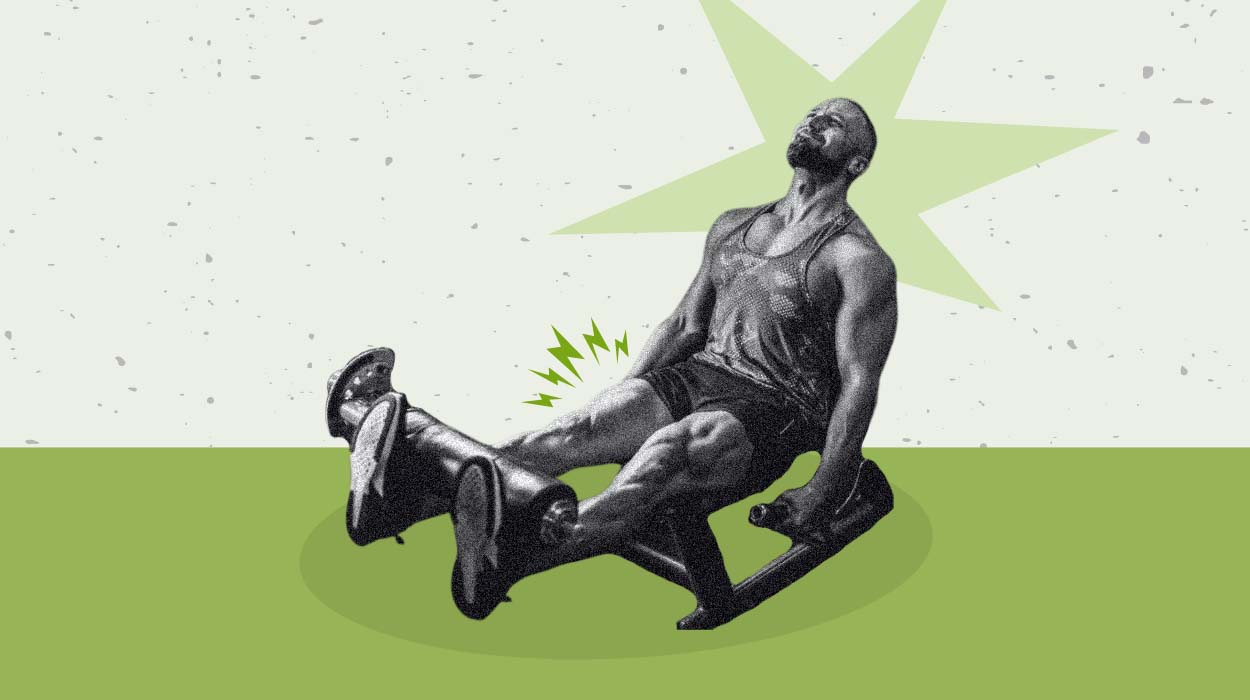
Leg workouts are a vital part of strength training, but are often missed as the legs are not really the show-off muscle, and let’s face it, leg workouts are hard! By including leg workouts, as well as observing good nutrition and supplementation, you can obtain an overall better physique and muscle strength. We all know it! Matchstick legs and a well-built upper body just look ridiculous.
For this reason, we have discussed the most effective leg workouts at the gym, the foods we should eat to help our recovery faster, whether we need supplements to support leg workouts or not, and more in this article.
10 Best Leg Exercises In 2024
Our top 10 exercises[1] to use during your leg workouts include:
Best Leg Workouts To Tone Your Lower Body
We have included a step-by-step for each of the 10 leg exercises that we recommend.
Barbell Back Squat
The barbell back squat is a fundamental exercise that targets the lower body, primarily focusing on the quadriceps, hamstrings, and glutes. It stimulates muscle growth in these areas, leading to enhanced muscle definition and size. This exercise also engages the core muscles, contributing to a stronger and more stable midsection.
Additionally, the barbell back squat promotes functional movement patterns, translating to improved performance in daily activities and sports. It can also enhance bone density and joint health, making it an excellent exercise for overall lower body development and injury prevention.
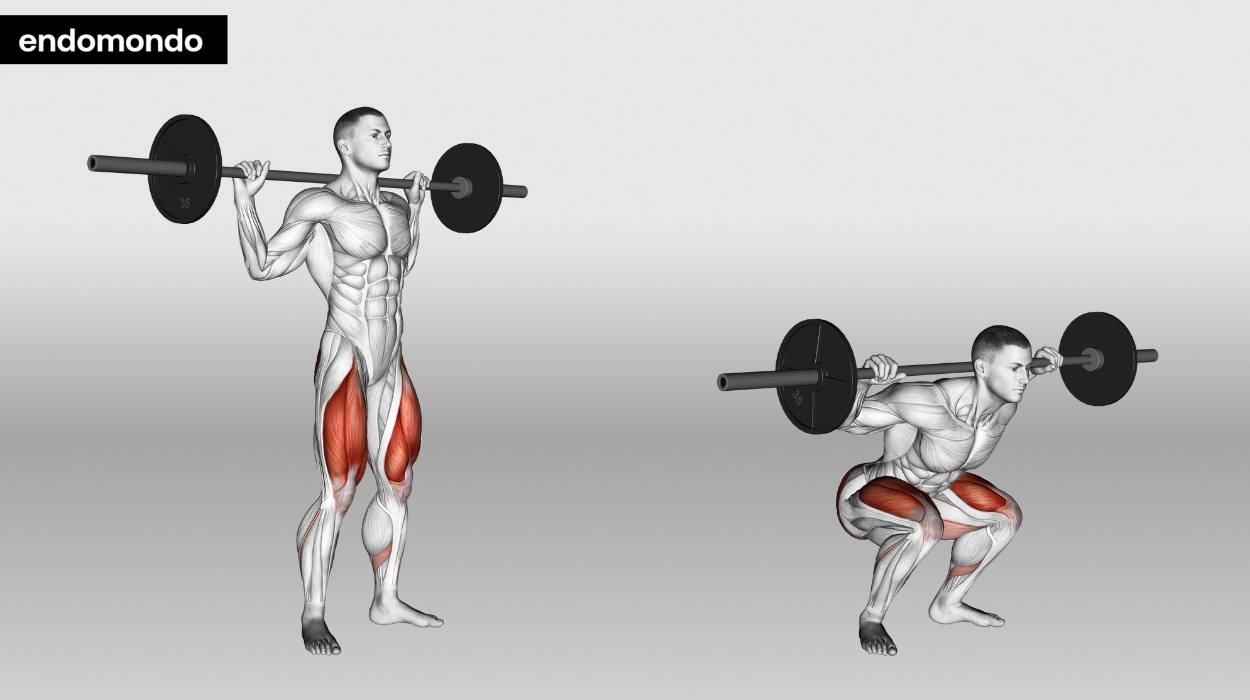
How to do:
- Place a bar on a squat rack around shoulder height, load it up, and then slot in some safety pins at your bottom squat position.
- Grasp the bar at shoulder width apart and feet flat in front of the bar.
- Dip underneath the bar and pin the shoulder blades back to make a base.
- Place the feet shoulder-width apart and in front of the bar to get into the starting position.
- Brace the core and extend at the knees and hips to drive the bar off the rack.
- Take 2-3 steps back and reset your foot position.
- Take a deep breath and brace at the core to ensure spinal neutrality throughout the movement.
- Start releasing the breath while driving the weight on the heels, and bend at the knees and hips while getting into your squat position.
- Take another deep breath and hold it.
- Press the weight into the midfoot, extend the knees and hips, then squeeze the glutes followed by releasing the breath.
- Repeat the movement for the desired amount of reps, then re-rack the bar onto the squat rack.
Tips:
- Maintain proper form to prevent injury and optimize results.
- Warm up your muscles and joints with dynamic stretches and mobility exercises before starting your session.
- Start with an appropriate weight and gradually increase the weight as your strength and technique improve.
Optimal Sets and Reps: 3-4 sets of 10-12 reps.
Barbell Deadlift
The barbell deadlift is a compound exercise that targets multiple muscle groups, primarily focusing on the posterior chain, including the muscles in the lower back, glutes, hamstrings, and even the core.
By engaging the posterior chain, the barbell deadlift helps to develop strength, power, and stability in the lower body. It promotes muscle growth and improves overall lower body function. The primary muscles worked during this exercise are the glutes and hamstrings, which are essential for hip extension and maintaining proper posture.
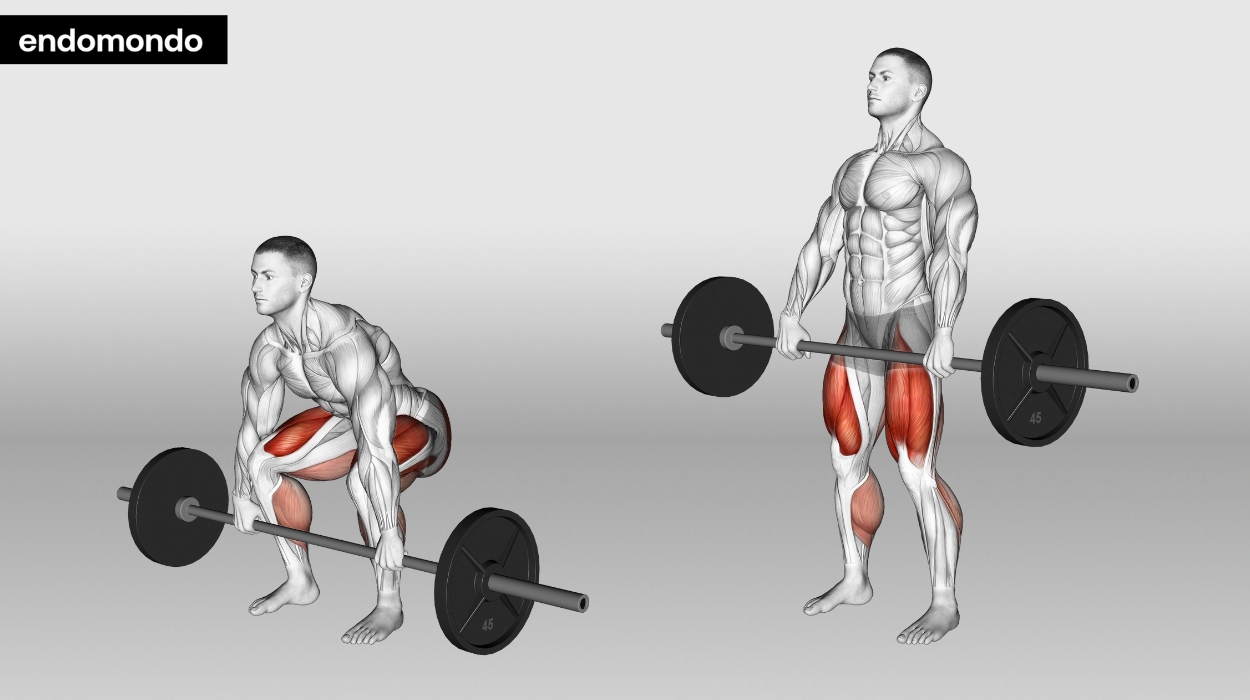
How to do:
- Place a bar on a clean, flat, and hard surface.
- Load the bar up.
- With the feet hip-width apart, line up to the bar and around one to two inches away from the shins.
- Grasp the bar with an overhand grip, around hip-shoulder width apart.
- Drive the hips back with the knees bent, drifting the weight onto the heels.
- Take a deep breath, then brace the core and lats.
- Drive the weight onto the midfoot, extend at the knees, and with a hip thrust get into a standing position.
- To finalize the movement pin the shoulder blades back and pull the upper arms backward working almost the entire body.
- Breathe out and drop the weight back to the ground.
- Reset the position for the next rep.
Tips:
- Engage your core by bracing your abs as if preparing to be punched.
- Maintain proper form for both safety and effectiveness.
- Start with a weight that allows you to maintain proper form and gradually increase the weight as you become stronger.
Optimal Sets and Reps: 3-4 sets of 10-12 reps.
Front Squat
The front squat is a compound exercise that primarily targets the muscles in the legs, particularly the quadriceps, while also engaging the glutes and core muscles. Unlike the traditional back squat, the barbell is positioned in front of the body, resting on the front shoulders.
By placing the load in front, the front squat places a greater emphasis on the quadriceps, making it an excellent exercise for building leg strength and muscle. It also activates the glutes and core muscles, promoting stability and balance throughout the movement.
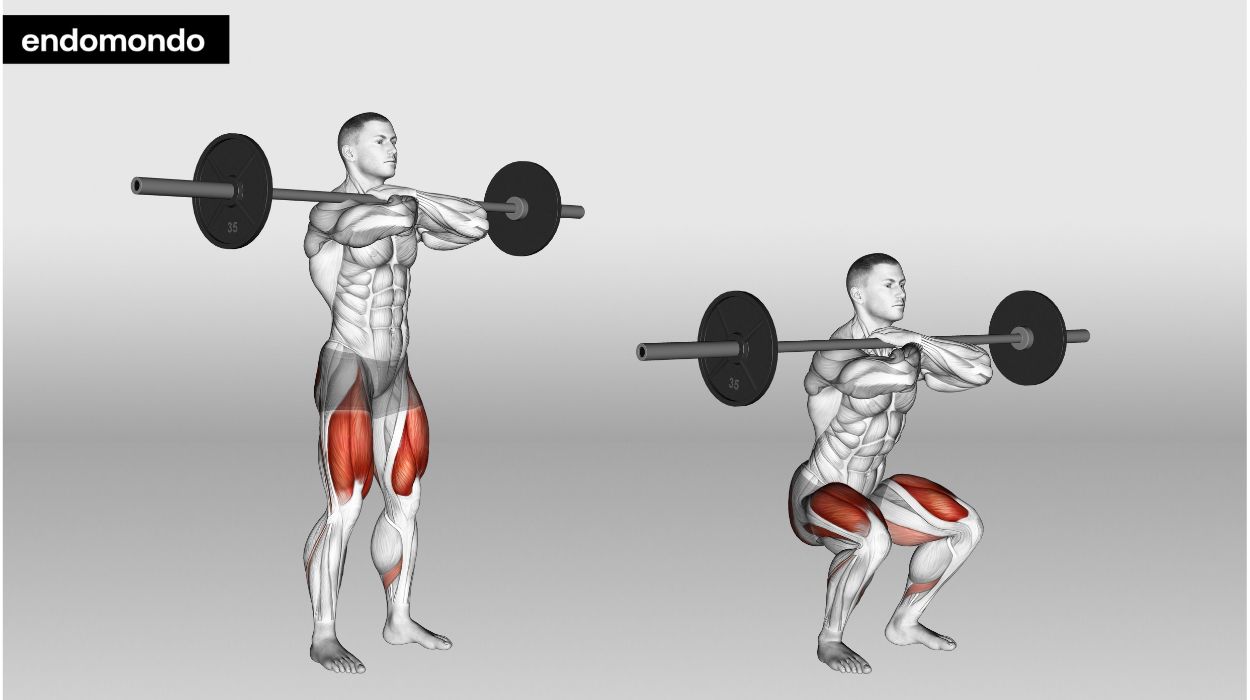
How to do:
- Place a bar on a squat rack around shoulder height, load it up, and then slot in some safety pins at your bottom squat position.
- Grasp the bar at a width apart and feet in front of the bar.
- Flex the elbows and place the bar on the front of the shoulders/upper chest.
- Place the feet shoulder-width apart and arch at the back slightly to get into the starting position.
- Brace the core and extend at the knees and hips to drive the bar off the rack.
- Take two or three steps back and reset your foot position.
- Take a deep breath and brace at the core to ensure spinal neutrality throughout the movement.
- Start releasing the breath while driving the weight on the heels, and bend at the knees and hips while getting into your squat position.
- Take another deep breath and hold it.
- Drive your weight into the midfoot, extend the knees and hips, then squeeze the glutes followed by releasing the breath.
- Repeat the movement for the desired amount of reps, then re-rack the bar onto the squat rack.
Tips:
- Practice holding the barbell across the front of your shoulders to master the rack position.
- Engage your core throughout the exercise by bracing your abs and maintaining an upright posture.
- Maintain proper knee alignment.
Optimal Sets and Reps: 4-6 sets of five reps.
Single Leg Deadlift With Dumbbells
The single-leg deadlift with dumbbells is a unilateral exercise that targets the hamstrings, glutes, and stabilizing muscles. By performing this exercise unilaterally, it helps to improve balance, stability, and symmetry in the lower body.
This exercise helps to build muscular strength and endurance, enhance hip stability, and improve overall lower body function. It can also help to correct muscle imbalances between the legs, reducing the risk of injury and improving athletic performance.
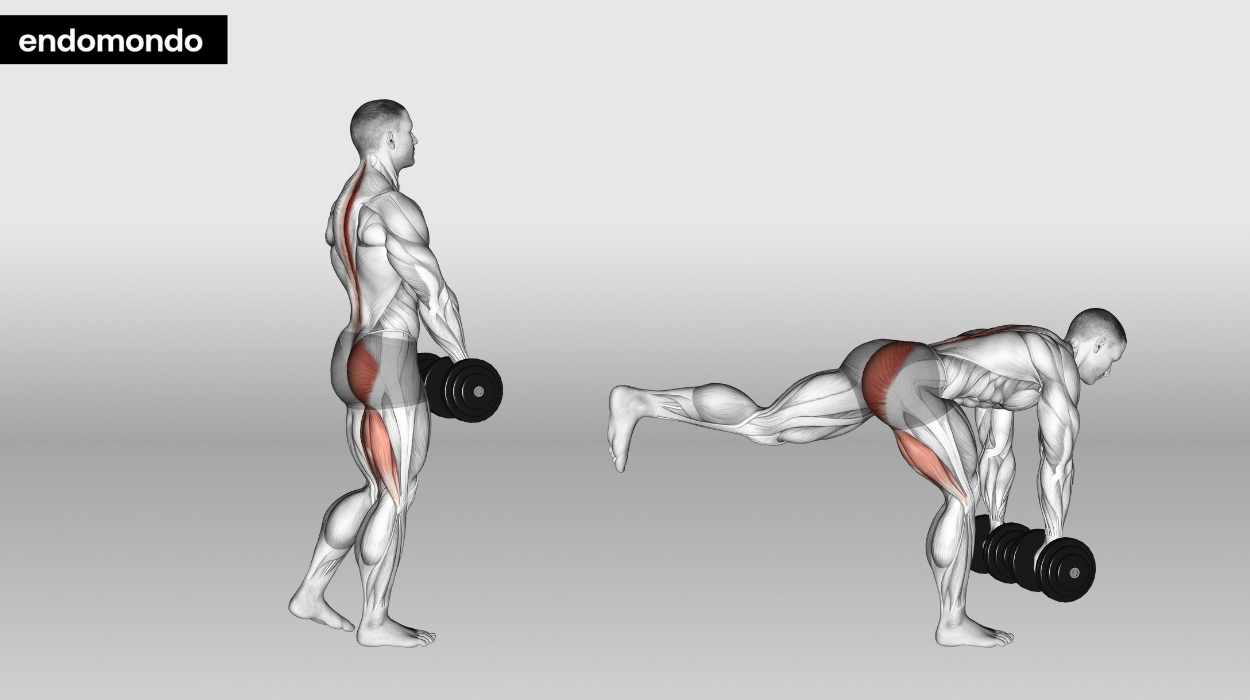
How to do:
- Place a pair of dumbbells on a clean flat and hard surface.
- Place the feet hip-width apart and bend the left knee to put all the tension on one leg.
- Drive the hips back, bend the knee, and drift the weight onto the heels.
- Grasp the dumbbells with a neutral grip.
- Take a deep breath, then brace the core and lats.
- Drive the weight onto the midfoot, extend at the knee, and with a hip thrust get into a standing position.
- To finalize the movement pin the shoulder blades back and pull the upper arms backward.
- Breathe out and drop the weight back to the ground.
- Reset the position for the next rep.
- Remember to work the left leg too (alternating legs between sets).
Tips:
- Establish a stable base.
- Hinge from the hips to target the posterior chain.
- Control the descent and maintain balance.
Optimal Sets and Reps: 2-3 sets of 10–12 reps on each leg.
Leg Press
The leg press is a popular resistance exercise that primarily targets the quadriceps, hamstrings, and glutes. By placing the focus on the lower body muscles, it helps to develop strong, powerful legs. The quadriceps are the primary muscles worked during this exercise, but the hamstrings and glutes are also engaged as secondary muscle groups.
One of the key benefits of the leg press is its versatility and accessibility. It allows individuals to lift heavy weights safely, making it suitable for beginners and advanced lifters alike. It can be used to increase muscle mass, improve muscular endurance, and enhance overall lower-body strength.
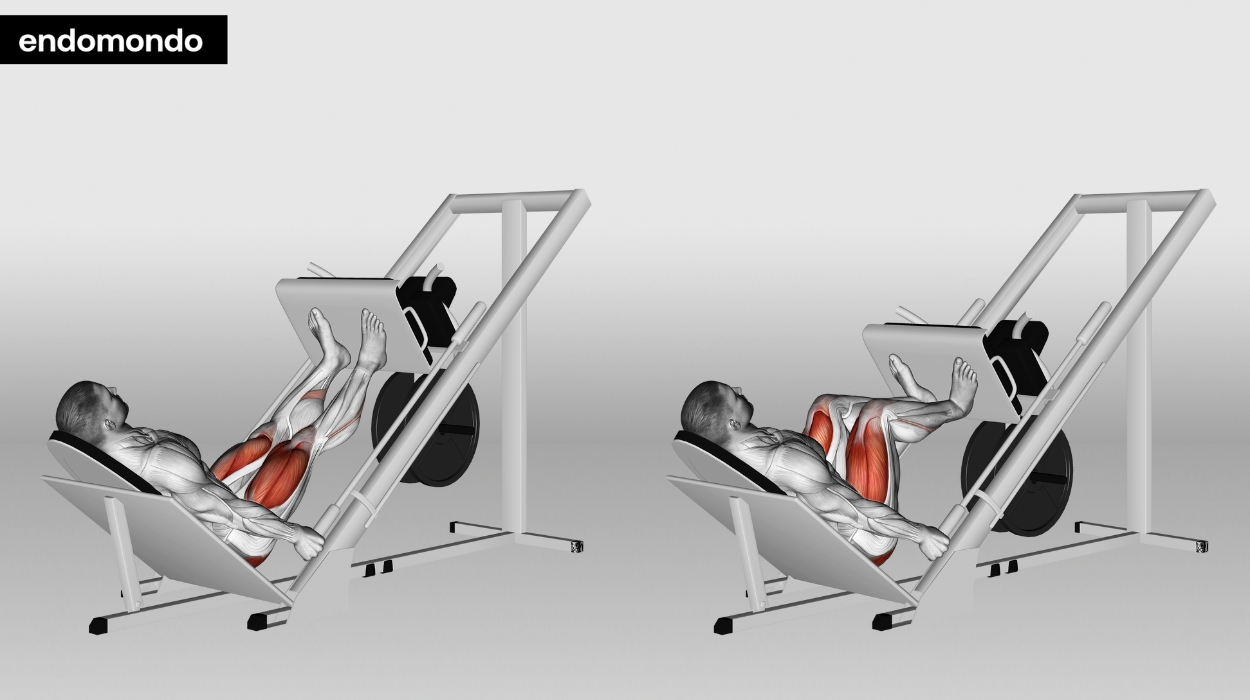
How to do:
- Sit on the leg press machine and select your load.
- Place the feet hip-shoulder width apart and the feet at an 11 o’clock and 1 o’clock angle on the leg press platform.
- Brace the core take a deep breath and press the platform off followed by releasing the safeties.
- Shifting the weight onto the heels, bend at the knees to bring the platform closer to the body, while slowly releasing the breath.
- Take another deep breath, then Press the platform from the mid-foot and extend at the leg, once the knees reach a 90-degree or shorter angle.
Tips:
- Adjust the machine for proper alignment.
- Focus on engaging your glutes and hamstrings throughout the movement.
- Control the movement and avoid locking your knees.
Optimal Sets and Reps: 3-5 sets of 12-15 reps.
Bulgarian Split Squat
This exercise particularly targets the quadriceps, glutes, and hamstrings. It focuses on one leg at a time, which helps to improve balance, stability, and muscular symmetry. It places a significant load on the quadriceps, making it an excellent exercise for building strength and size in the front of the thighs.
In addition to targeting the quads, the Bulgarian split squat also engages the glutes and hamstrings, helping to develop a well-rounded lower body. It improves lower body strength, stability, and flexibility, while also enhancing hip mobility and core stability.
One of the key benefits of the Bulgarian split squat is its versatility, as it can be performed with body weight or added resistance like dumbbells or barbells. It offers a great option for individuals looking to challenge their legs and add variety to their leg muscles workout.
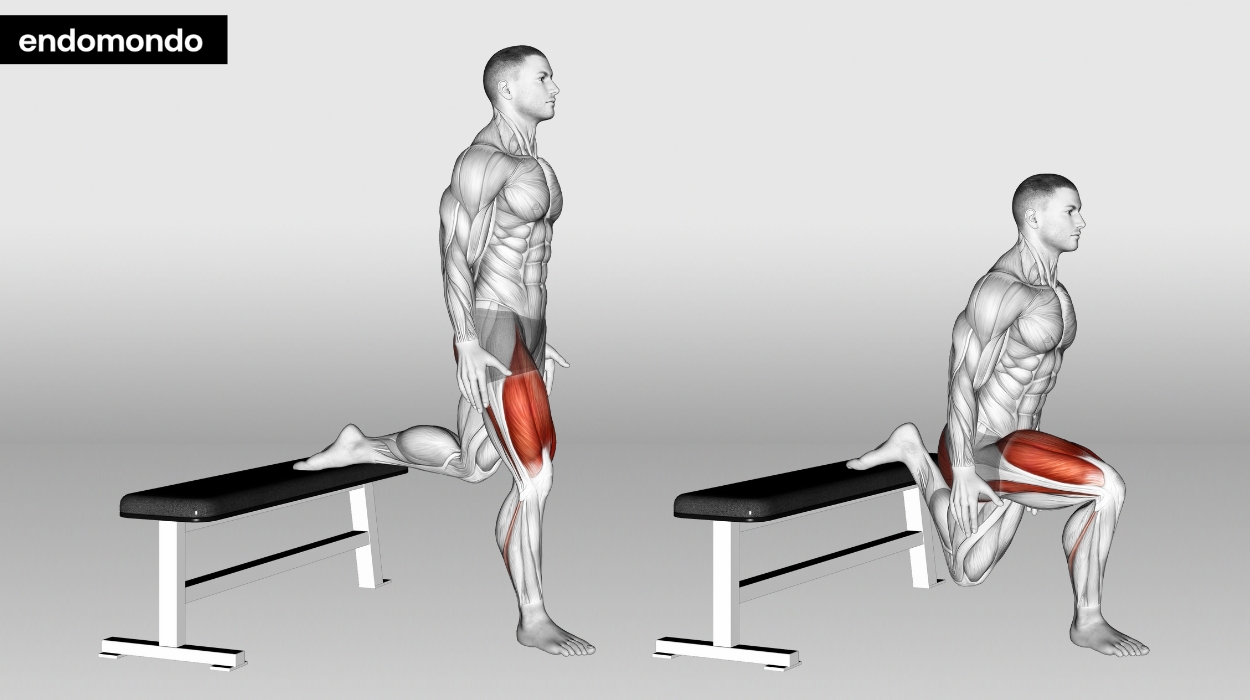
How to do:
- Set up an exercise bench with some dumbbells.
- Grasp the dumbbells and place the front one of the feet (i.e., left foot) onto the center of the exercise bench. This must be in a horizontal position.
- Ensure that the other foot is flat on the ground and the core is braced to create a split position.
- Squat down by putting the weight onto the back of the front foot and bending at the knee.
- Take a deep breath, then press from the mid-foot and extend at the knee and hip joint to complete the lift.
- Repeat the exercise for the desired rep range and make sure that you alternate the feet.
Tips:
- Focus on maintaining a stable position throughout the exercise.
- Maintain a slow and controlled movement to engage the muscles properly and reduce the risk of injury.
- Engage your glutes and legs to develop strength and stability in your lower body.
Optimal Sets and Reps: 4-6 sets of 6 reps.
Walking Lunges
Walking lunges are a dynamic and functional exercise that targets multiple muscles in the legs. It primarily works the quadriceps, which are responsible for extending the knee joint. However, they also engage the hamstrings, glutes, and calves as stabilizing muscles. This exercise helps to strengthen and tone the entire lower body, improving leg strength, power, and endurance.
One of the key benefits of walking lunges is that they mimic natural walking or running movements, making them highly functional for everyday activities and sports performance. They help to improve balance, coordination, and stability, while also enhancing hip mobility and core strength.
This exercise can be adjusted to suit various fitness levels. Beginners can start with bodyweight lunges, while more advanced individuals can add weights, such as dumbbells or a weighted vest, to increase the challenge.
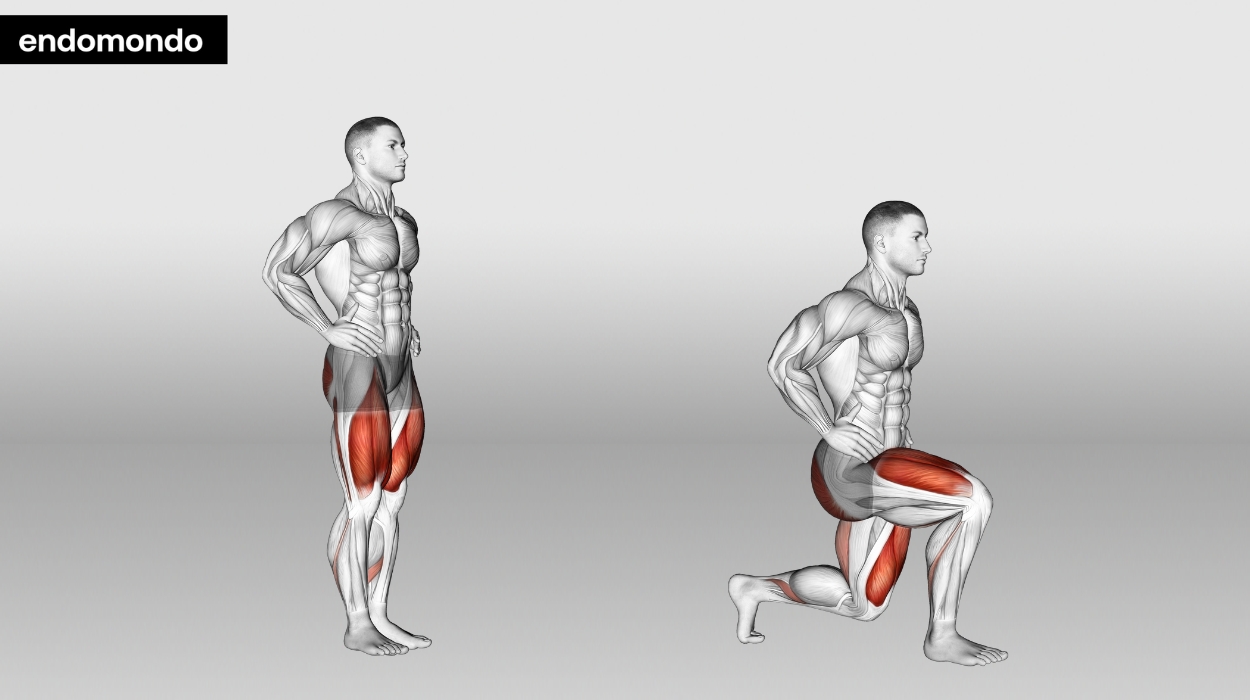
How to do:
- Start in an upright position with your feet together and arms relaxed at your sides.
- Take a step forward with your right leg, creating a 90-degree angle at both knees.
- Lower your body by bending both knees simultaneously, ensuring your left knee hovers just above the ground.
- Push off your right foot to return to the starting position, then alternate with your left leg and continue walking forward.
Tips:
- Avoid leaning forward or rounding your back.
- Take long strides to engage your glutes and hamstrings effectively.
- Keep your knees in line with your toes.
Optimal Sets and Reps: 2-3 sets of 10-15 reps on each side.
Leg Extension
The leg extension is a popular isolation exercise that primarily targets the quadriceps muscle group in the front of the thigh. It provides a concentrated and intense workout for this group, helping to develop strength, size, and definition in the front of the thigh.
The leg extension is an effective exercise for individuals looking to primarily focus on building stronger quads. It also helps to improve knee stability and enhance overall lower body strength.
This exercise is relatively safe and easy to perform, making it suitable for most fitness levels. It can be used in various training programs, such as leg hypertrophy workouts or rehabilitation exercises for knee injuries.
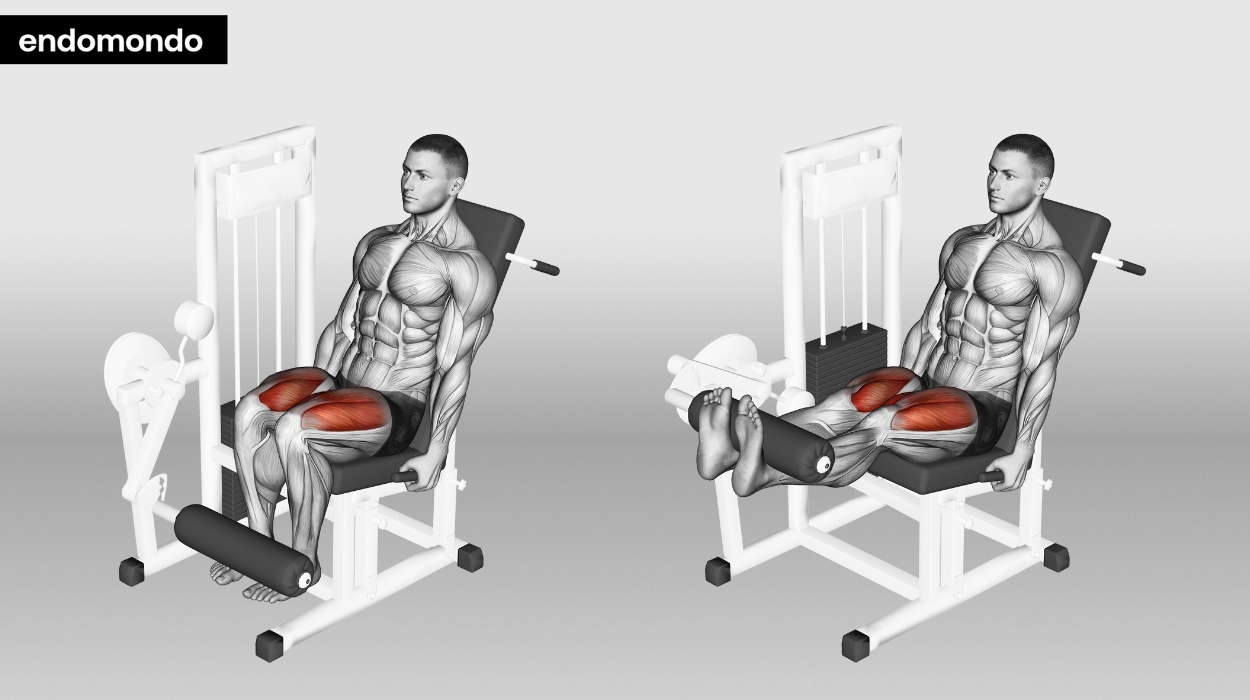
How to do:
- Sit on a leg extension machine with the lowest part of the shins against the extension pad.
- Select the desired weight for the targeted rep range.
- Hold the leg extension handles, brace the core, and take a deep breath.
- Extend the knees and lift the pad, more formally known as keeping the lower legs straight.
- Slowly lower the leg extension pad and then repeat the movement.
Tips:
- Adjust the machine to fit your body.
- Focus on squeezing your quadriceps at the top of the movement.
- Avoid locking your knees to prevent potential injuries.
Optimal Sets and Reps: 3 sets of 10-12 reps.
Leg Curl
This exercise primarily targets the hamstrings, the muscles located at the back of the thigh. It is commonly performed on a leg curl machine or using resistance bands.
The leg curl helps to strengthen and develop the hamstring muscles, improving their size, strength, and stability. Strong hamstrings are crucial for overall lower body function and performance, as they play a significant role in knee flexion and hip extension movements. Additionally, strong hamstrings can help prevent injuries, such as strains or tears, especially for athletes involved in activities that require explosive movements or rapid changes in direction.
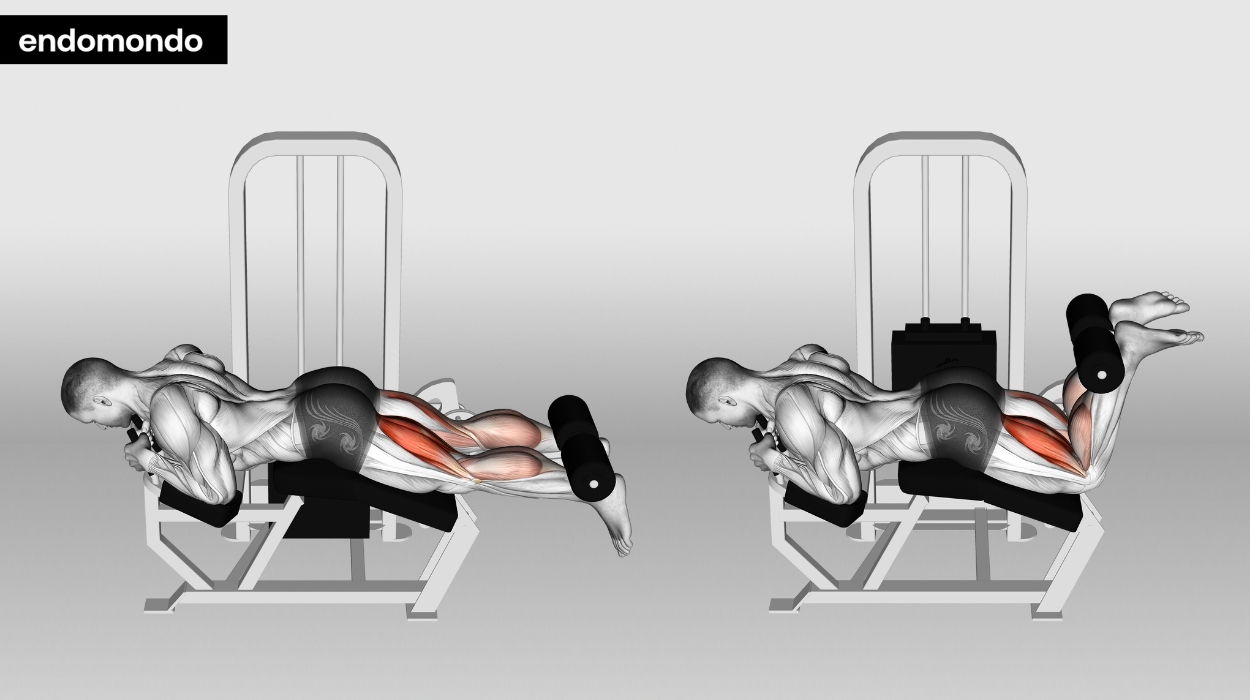
How to do:
- Sit on a leg curl machine with the legs in an extended potion and the calf muscles against the pad.
- Select the desired weight for the targeted rep range.
- Hold the leg extension handles, brace the core, and take a deep breath.
- Flex the knees to lower the pad, more formally known as curling the lower leg.
- Slowly allow the weight back up to the starting position before curling again.
Tips:
- Adjust the machine to fit your body.
- Focus on engaging your hamstrings.
- Avoid arching your lower back or lifting your hips off the bench.
Optimal Sets and Reps: 2-4 sets of 15-20 reps.
Sprinting
Sprinting is an explosive and high-intensity exercise that primarily targets the muscles in the legs, especially the quadriceps, hamstrings, glutes, and calves. This exercise involves running at maximum speed for a short distance.
Sprinting is a highly effective leg workout as it engages multiple muscle groups simultaneously, helping to build strength, power, and endurance in the lower body. The explosive nature of sprinting places a significant demand on the muscles, leading to increased muscle fiber recruitment and development.
Regular sprinting can enhance running mechanics, stride length, and overall sprinting technique. It also helps to improve cardiovascular fitness and burn calories, making it an effective exercise for weight loss.
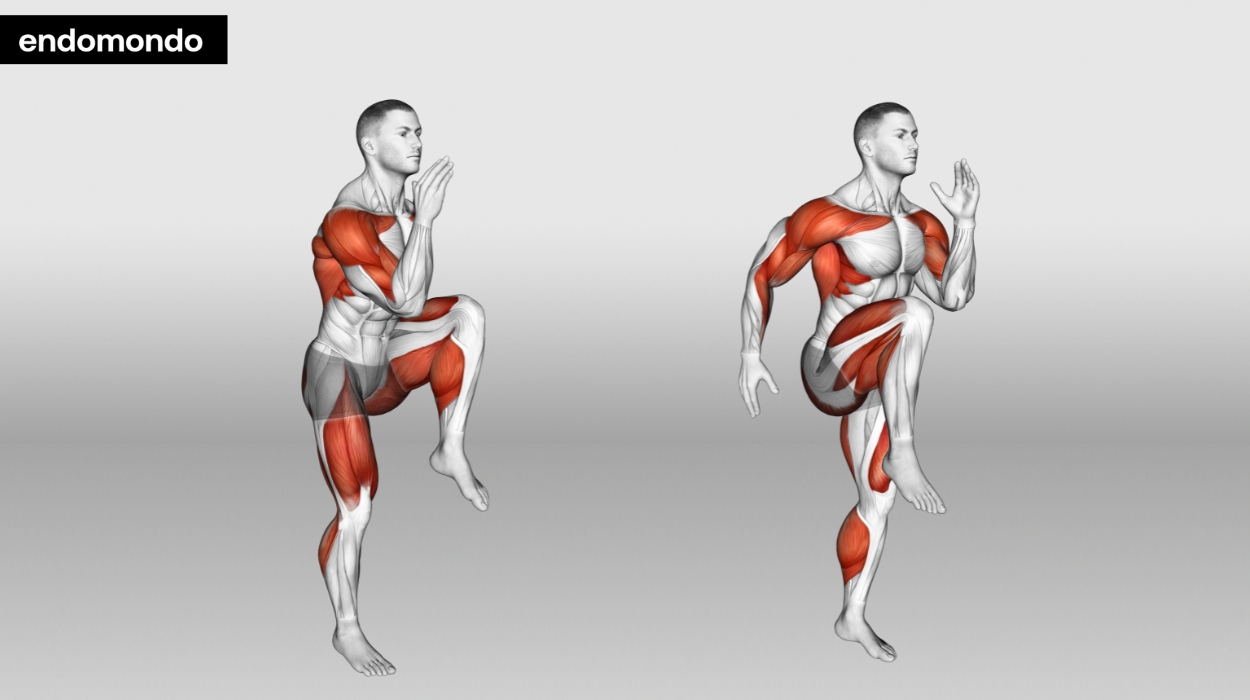
How to do:
- Stand with your feet hip-width apart, leaning slightly forward, and arms bent at a 90-degree angle.
- Explode forward by driving your knee and swinging your arms back and forth.
- Sprint with quick, powerful strides, keeping your head up and breathing rhythmically.
Tips:
- Warm up properly to prevent injuries and enhance performance.
- Maintain good running form when sprinting to optimize efficiency and minimize the risk of injury.
- Start with shorter distances and slower speeds, and gradually increase both as your fitness level improves.
Optimal Sets and Reps: 4-6 sprints per session for beginners, 10-12 or more for experienced ones.
Leg Workout Routine Samples
We have put together 3 sample leg workout routines. Sample 1 would probably suit someone who is intermediate-advanced and Sample 3 may suit someone who is Novice-intermediate level.
Sample 1
| Exercise | Intensity | Sets x Reps | Rest |
| Barbell Back Squat | 75% | 5 x10 | 90 seconds rest in between sets |
| Leg Extension | 70% | 3 x 12 | 60 seconds rest in between sets |
| Hamstring Curls | 70% | 3 x 12 | 60 seconds rest in between sets |
| Hill Sprints | 6 sprints | Three minutes rest between sprints, 60 seconds rest in between sets |
Sample 2
| Exercise | Intensity | Sets x Reps | Rest |
| Front squat | 80% | 5 x 10 | 120 seconds rest in between sets |
| Bulgarian Split Squat | 65% | 3 x 12 | 60 seconds rest in between sets |
| Hamstring Curls | 70% | 3 x 12 | 60 seconds rest in between sets |
| Sprints | 6 sprints | Three minutes rest between sprints, 60 seconds rest in between sets |
Sample 3
| Exercise | Intensity | Sets x Reps | Rest |
| Barbell Deadlift | 80% | 3 x 10 | 120 seconds rest in between sets |
| Walking Lunges | 70% | 3 x 12 | 60 seconds rest in between sets |
| Hamstring Curls | 70% | 3 x 12 | 60 seconds rest in between sets |
Why Do We Need Leg Day Workout?
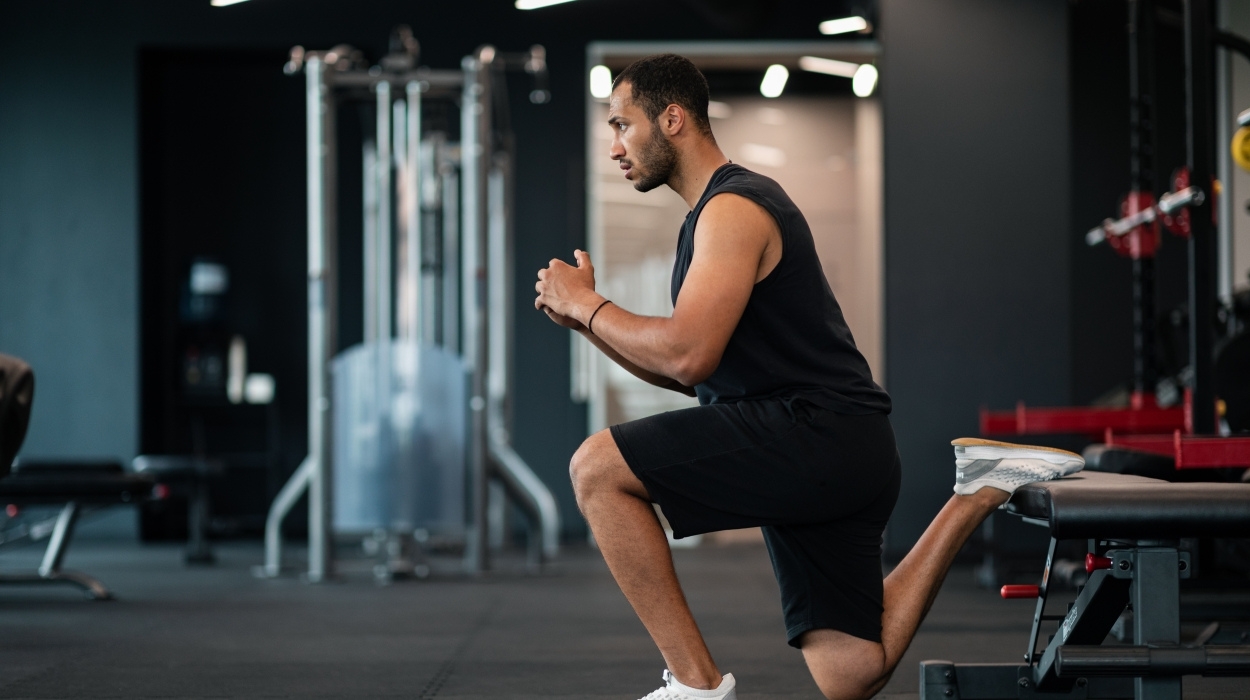
Leg workouts are absolutely crucial to strengthening and building the lower body[1] or as we like to call them leg muscles. Leg workouts will target the muscle growth of the: calves, quadriceps, hamstrings, glutes, and even the upper body to some extent.
Another reason why we may need a leg workout is that it activates a lot of muscles of the body, which can then burn through a lot of energy/calories. This outcome may allow you to sustain a healthy body weight by maintaining an energy balance.
It may even help to lose weight if we are able to drive a caloric deficit. However, this usually requires us to dial in all of the weight loss components, which include: exercise, exercise-induced thermogenesis, energy/food intake, and the thermic effect of food.
Foods To Have In Your Diet
High Protein Foods
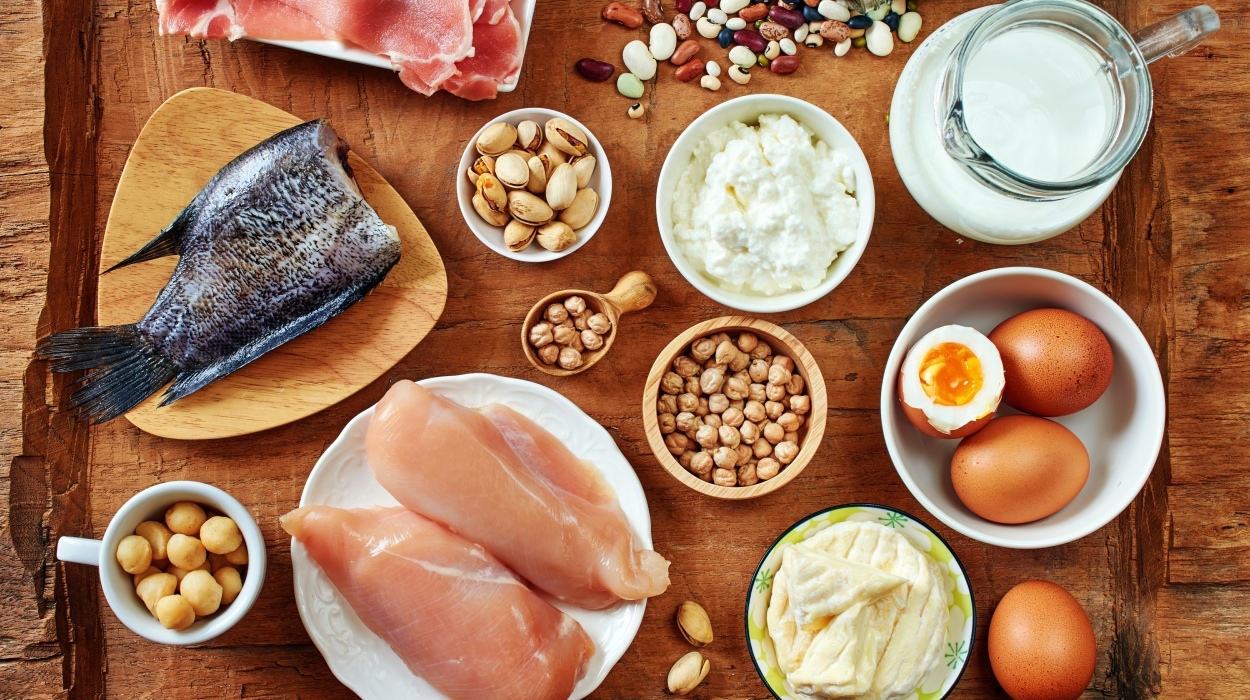
Proteins are the building blocks for muscle,[2] therefore a sufficient consumption of -2-2.2 grams/kilogram or ~1 gram/pound can maximize muscle recovery and building response after difficult leg training.
The higher the essential amino acid content/leucine, the less of the food source would be needed to maximize muscle protein synthesis per meal. Without getting into detail, we aim for 2-3 grams of leucine per meal and try to eat every three hours to counter the effect of elevated muscle protein degradation.
Leucine is the branched-chain amino acid responsible for elevating muscle protein synthesis, something called mTOR.
In order of leucine concentration, high protein foods that you could include in your area:
- Whey Protein
- Milk
- Egg
- Casein
- Salmon
- Whitefish
- Tuna
- Sardines
- Chicken Breast
- Chicken legs
- Chicken thighs
- Wheat
- Soy
Carbohydrates
Carbohydrates are the main source of energy. Once carbohydrate-rich foods are ingested they are broken down into glycogen, which is then stored within the muscles, liver, and brain.
This glycogen is then drawn to produce energy/ATP through a few processes called: glycolysis, the Kreb cycle, and the electron transport chain.
Each molecule of glycogen produces ATP, thereby highlighting the importance of observing a carbohydrate-rich diet, especially for leg workouts. Why so? Leg workouts stimulate a lot of movement and muscle mass, thereby drawing a lot of energy.
The amount of carbohydrates that you consume per day depends on how active you are. Typically for those only engaging in resistance training i.e., leg workouts, we recommend around 2-3 grams/kilogram of body weight.
Carbohydrate-rich sources that you could include in your diet could be:
- Rice
- Pasta
- Bread
- Potatoes
- Sweet Potato
- Noodles
- Sugar
- Banana
- Apples
- Strawberries
Dietary Fats
Healthy dietary fat is the third macronutrient. It is often overlooked because it is the most caloric dense with 9 kilocalories per 1 gram. However, dairy fat consumption is crucial for keeping hormones balanced and it provides some energy for exercise. We do not really go over 0.5-1 gram/kilogram of body weight.
Dietary fat sources could include:
- Olive oil
- Coconut oil
- Flaxseed oil
- Almonds
- Walnuts
- Cashew nuts
- Fat within meats and fish
Should We Use Supplements To Support Leg Workouts?
Supplements are not necessary, but to maximize results there are a couple of supplements that we do recommend.
Pre-Workout
You may want to try a pre-workout that contains caffeine and a pump ingredient like citrulline malate.
Caffeine at a dose of 3-6 milligrams/kilogram can inhibit the maximum amount of adenosine receptors in the brain. The adenosine receptors are responsible for making us feel relaxed. So, deactivating them will stimulate the central nervous system and provide extra energy.[3]
Citrulline malate at a dose of 6-10 grams can be converted into arginine via the kidneys. This will increase the concentration of nitrogen oxide (N.O) molecules in the bloodstream. N.O. will draw vasodilation of the blood vessels and allow for a better oxygen uptake and muscle pump effect.
Generally, we are looking at 200-300 milligrams of caffeine with citrulline malate 30-45 minutes before a leg workout.
Many pre-workout products contain these two ingredients in similar doses.
Creatine Monohydrate
Moreover, creatine monohydrate may help to produce powerful movements. Creatine helps to recycle the creatine phosphate system and modify short bursts of movements.
You would typically ingest 5 grams per day which would saturate muscle cells within 28 days. Another method can be loafing 20 grams of creatine for a week, followed by a 5-gram maintenance.
Cycling on and off creatine is not required. Furthermore, long-term use has yet to be shown to be dangerous. So ideally you would use creatine for as long as you strength train.
Conclusion
Leg workouts are essential for health and fitness. There is a wide variety of the best leg exercises that you could include in your program like the barbell back squat and leg curl.
To maximize results, you could also take into account diet and supplementation. It is important to get sufficient protein, carbohydrates, and fats to provide recovery, energy, and hormonal balance.
In terms of supplementation, pre-workouts with caffeine and a pump ingredient can give you an exercise boost. Last but not least, long-term use of creatine can benefit high-intensity leg workouts.
Frequently Asked Questions
They build and strengthen the muscles of the legs and burn lots of calories.
Barbell back squats! It activates the most muscle and burns the most calories.
You don’t need to as there are a variety of exercises that can work the leg muscles. In my opinion, squats are the best though.
Resources
- Ebben, W.P., Feldmann, C.R., Dayne, A., Mitsche, D., Alexander, P. and Knetzger, K.J. (2008). Muscle Activation during Lower Body Resistance Training. International Journal of Sports Medicine, [online] 30(01), pp.1–8. doi:https://doi.org/10.1055/s-2008-1038785.
- Thalacker-Mercer, A., Riddle, E. and Barre, L. (2020). Protein and amino acids for skeletal muscle health in aging. Advances in food and nutrition research, [online] pp.29–64. doi:https://doi.org/10.1016/bs.afnr.2019.08.002.
- Markus Estifanos Haugen, Fredrik Tonstad Vårvik, Grgic, J., Henrik Studsrud, Espen Austheim, Erik Mathias Zimmermann, Hallvard Nygaard Falch, Larsen, S., Roland and Bjørnsen, T. (2023). Effect of isolated and combined ingestion of caffeine and citrulline malate on resistance exercise and jumping performance: a randomized double-blind placebo-controlled crossover study. European Journal of Nutrition, [online] 62(7), pp.2963–2975. doi:https://doi.org/10.1007/s00394-023-03212-x.




